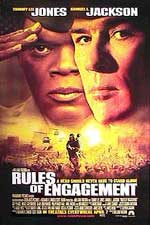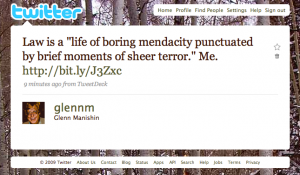OK, so my new colleague Ryan Wynia at BeYOB.com posted, in bullet form, the “rules of engagement” for social media for businesses I presented at SPARKt2 in Chicago on April 29. Glenn Manishin’s Rules of Engagement [BYOB]. But that short treatment misses some of the nuances, and besides, I thought of them first! So here are my six rules of engagement for social media — Twitter, Facebook, etc.– all of which can be summed up in the phrase “if you are going to do it, do it right.”
1. Be Authentic…Have an Identity. When using social media for business, you must establish a unique identity. While the early Web was accompanied by the slogan “No one knows if you are a dog on the Internet,” social media are different. Reputation and credibility flow from identity. If you want to develop business via social media, don’t be anonymous and do not be a cartoon. Logos may be fine for corporate PR and customer relations postings, but without a profile photograph, bio and link, audiences will be far less likely to follow you and even less willing to believe what you say.
2. Offer Value (Content), Not Self-Promotion. This should be a no-brainer. When participating in social media, what is of interest to other members is substance. Despite popular misconceptions, social networking is not about revealing what one ate for breakfast. Rather, it is providing domain expertise to others by sharing one’s knowledge, experience and insights. Twitter is filled, for instance, with get-rich quick and Web marketing schemes, life coaches, success gurus, MLM schemers and others engaged in overt sales pitches. They are rapidly becoming classified as “Twitter spam” and rightfully ignored. To gain an audience, talk about what you know, not what you sell.

3. Listen to the Audience. A corollary to rule #2, stay sensitive to “trending” topics and engage on matters of relevance to the audience. That means listening as much as talking on social media sites. A traditional maxim for negotiations is that one must acknowledge the views and statements of others (”I hear what you say…“) before responding, especially if critiquing. By engaging after listening, one can ensure that posts and updates reflect the issues on which the audience is looking for information. And by providing it, you can and eventually will gather your own audience of followers and readers.
4. Tone Matters. “Social stream” is rapidly replacing email as a dominant form of digital communication. But even more than email, social presence and status updates are communicated in near real-time, meaning that hitting the “post” or “update” button without thinking about the wording of your content can be disastrous. Mainstream media is filled with stories of employees being disciplined or fired, and applicants rejected, because of inappropriate “Tweets.” This is so way more problematic than a college student uploading drunken beer pong photos to Facebook or Flikr. Sacrcasm reads even worse on social media than it does in email. Avoid flame wars at all costs!
5. Follow, Answer and “Retweet.” The Web is about content and community, not technology. So after adjusting to the immediacy of social streaming, the most important aspect of doing business on social media is engaging that community by participating as a full-fledged member. Lurking is dated and counterproductive. Interact with others, promote good ideas by following and reposting authors. The more you participate the more you can profit in the long run.
6. Remember That “Tweets Live Forever.” Nothing one posts on social media sites goes away, even after one quits. Facebook, for instance, made clear in February that content shared with other members survives if a member cancels his or her subscription. Blog comments, Twitter posts, etc., are archived and indexed by Web bots and spiders almost instantly. You can delete a Tweet, but chances are almost 100% it remains visible to the world. So when posting content, ask the old question–would you want your update to appear on the front page of the New York Times? If the answer is no, trash it and move on. Remember, social media for business is about brand and reputation building. You will never sell anything if your “recalled” updates brand you as a loose cannon or a curmudgeon.
What do you think? Reactions appreciated. You can also check out my companion post on SiliconANGLE.



